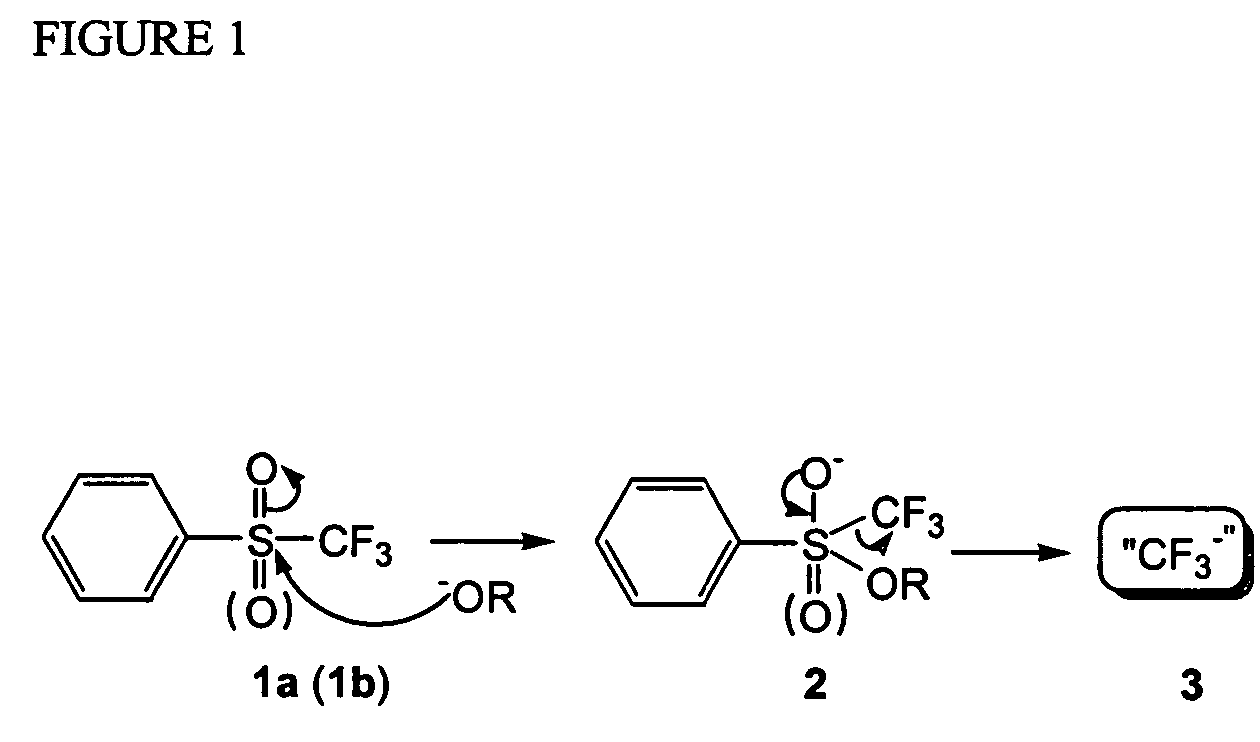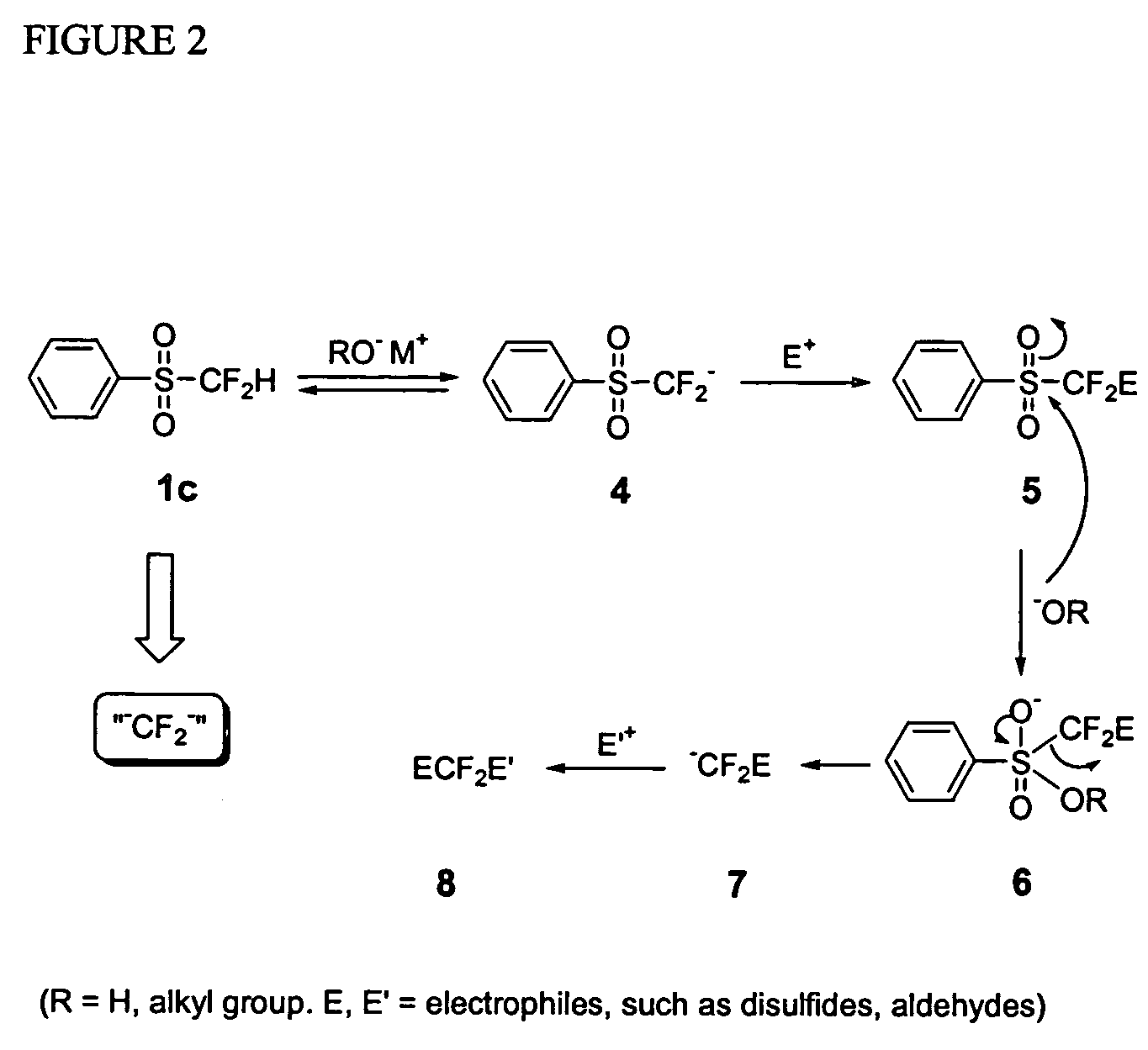Methods for nucleophilic fluoromethylation
a technology of nucleophilic fluoromethylation and nucleophilic fluoromethyl, which is applied in the preparation of carbonyl compounds, organic chemistry, chemistry apparatus and processes, etc., can solve the problems of inconvenient laboratory handling of reagents, the failure of attempts to react with carbonyl compounds, and the drawbacks of all these methods of trifluoromethylation or difluoromethylation
- Summary
- Abstract
- Description
- Claims
- Application Information
AI Technical Summary
Benefits of technology
Problems solved by technology
Method used
Image
Examples
example 1
Preparation of 4-Methyl-α-phenyl-α-(trifluoromethyl)benzenemethanol
[0059]Into a dry Schlenk flask under an argon atmosphere, was added 7 mL DMF solution of phenyl trifluoromethyl sulfone (1a, 420 mg, 2 mmol) and 4-methylbenzophenone (196 mg, 1 mmol) at −50° C., was added 3 mL DMF solution of tBuOK (280 mg, 2.5 mmol). The reaction flask was then sealed and the reaction mixture was then stirred from −50° C. for 1 h, followed by stirring at −50° C. to room temperature overnight. The reaction mixture was quenched with 10 mL of ice water, and extracted with ether (20 ml×3). The combined ether phase was washed with saturated NH4Cl aqueous solution, followed by washing with water. After drying over MgSO4, the ether solvent was removed under vacuum. The crude product was further purified by column chromatography (hexanes / ether=9 / 1) to give 225 mg of product, 4-methyl-α-phenyl-α-(trifluoromethyl)benzenemethanol as a colorless oily liquid, yield 85%. 1H NMR (CDCl3): δ 2.36 (s, 3H); 2.89 (s, 1...
example 2
Preparation of 1-Phenyl-2,2,2-trifluoroethanol
[0060]The reaction condition is similar as described in Example 1 except that benzaldehyde was used as the substrate. Product 1-Phenyl-2,2,2-trifluoroethanol was isolated as a yellow oily liquid, 77% yield. 1H NMR (CDCl3): δ 2.86 (s, 1H); 5.01 (q, 3JH-F=6.3 Hz, 1H); 7.43 (m, 2H); 7.48 (m, 3H). 19F (CDCl3): δ−78.5 (d, 3JH-F=6.2 Hz). MS: 176 (M+).
example 3
Preparation of 1-(2′-Naphthyl)-2,2,2-trifluoroethanol
[0061]The reaction condition is similar as described in Example 1, except that 2-naphthaldehyde was used as the substrate. Product 1-(2′-naphthyl)-2,2,2-trifluoroethanol was isolated as a yellow solid, 62% yield. 1H NMR (CDCl3): δ 2.76 (b, 1H); 5.19 (q, 3JH-F=6.7 Hz, 1H); 7.51–7.96 (m, 7H). 19F (CDCl3): δ−78.4 (d, 3JH-F=6.7 Hz). MS: 226 (M+).
PUM
| Property | Measurement | Unit |
|---|---|---|
| time | aaaaa | aaaaa |
| temperature | aaaaa | aaaaa |
| temperature | aaaaa | aaaaa |
Abstract
Description
Claims
Application Information
 Login to View More
Login to View More - R&D
- Intellectual Property
- Life Sciences
- Materials
- Tech Scout
- Unparalleled Data Quality
- Higher Quality Content
- 60% Fewer Hallucinations
Browse by: Latest US Patents, China's latest patents, Technical Efficacy Thesaurus, Application Domain, Technology Topic, Popular Technical Reports.
© 2025 PatSnap. All rights reserved.Legal|Privacy policy|Modern Slavery Act Transparency Statement|Sitemap|About US| Contact US: help@patsnap.com



